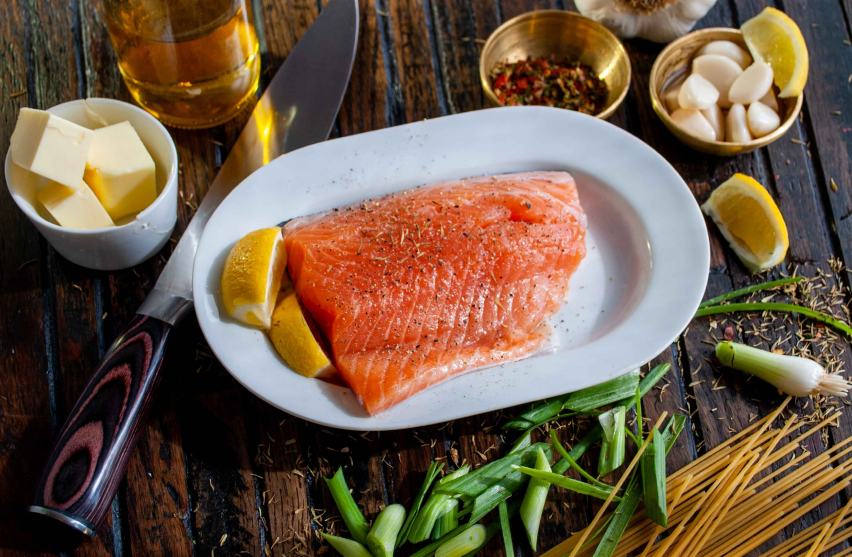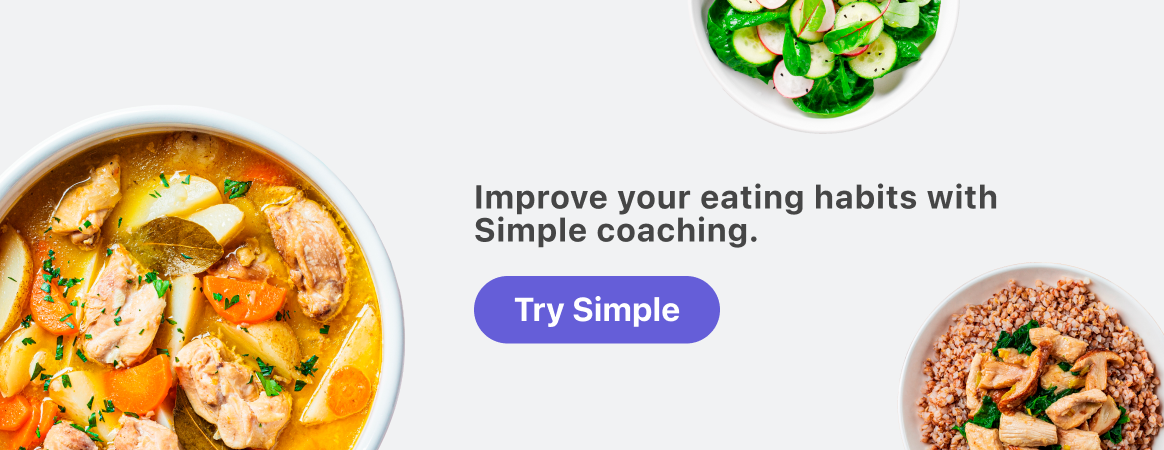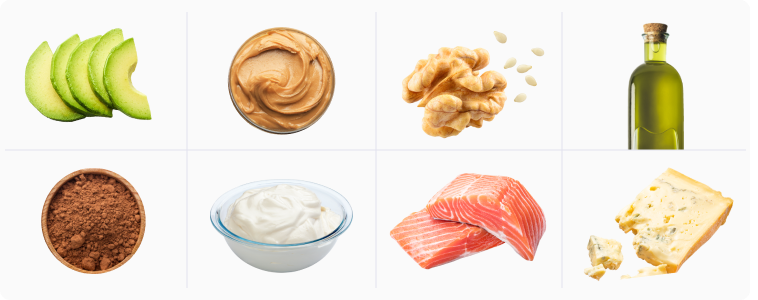Intermittent fasting and keto — a simple guide by Simple

Intermittent fasting and keto seem to go hand in hand.
Many people do them together.
Why is that?
Well, it’s thought that as intermittent fasting causes ketosis, adding the keto diet to your intermittent fasting efforts will maximize the fat-burning and wellness results you can get.

So … double whammy. If you do keto AND intermittent fasting, you can burn body fat like no tomorrow. Right?
Well, let’s see if that’s true.
Here’s everything you should know about intermittent fasting and the keto diet.

What is intermittent fasting?
Intermittent fasting is a way of eating that includes periods of fasting — i.e., your calories are restricted for a while — alternated with eating your regular diet.
There are several different intermittent fasting schedules, such as:
- time-restricted eating (TRE), like 16:8 or 14:10
- the 5:2 diet
- the Warrior Diet
- alternate-day fasting
Probably the most popular intermittent fasting schedule is 16:8 intermittent fasting. On this schedule, you have an 8-hour eating window and a 16-hour fasting window (much of which happens overnight).
Lots of people use intermittent fasting to lose weight, but there are many other benefits of intermittent fasting, from reduced inflammation to better blood sugar control to decreased belly fat.
You can read more about the various intermittent fasting schedules and their effects here: intermittent fasting for beginners.
What is the keto diet?
The keto diet is one of THE most popular diets around right now. (Thanks, Mr. Atkins.)
On keto, your diet would be:
- high fat (about 80% of your daily food intake)
- low to moderate protein
- very low carb (around 20–50 g a day)
The idea is that, by eating such a low-carb diet, your body will have to use fat for energy instead of glucose, and over time, fat will become your primary fuel source.
This is what’s known as being in ketosis, and it causes weight loss because, by keeping insulin levels low, we are better able to break down excess fat.
Keto has been shown to be effective for weight loss. And it’s thought to have a few other things going for it, too. For instance, it may:
- improve symptoms of Alzheimer’s disease [1]
- reduce insulin resistance [2]
- lower triglyceride levels [3]
On the face of it, keto seems easy. And tasty! One of fat’s most winning features is that it makes food taste great, so who wouldn’t want to believe that eating more high-fat foods would be a party all the way to the weight loss bank?
Yet it’s not quite as easy — or perhaps even as effective — as it seems.
In order to achieve that all-important super-low-carb state, a keto diet dumps foods like whole grains and fruits. So our intake of fiber and micronutrients, which we need for health, takes a big hit.
And, while the keto diet appears to work for weight loss, much of that may be water weight (which isn’t really the kind of weight loss we hanker after, is it?). Add to that the fact that any diet with a strict macronutrient split is pretty dang tough to stick to, and it’s far from clear that keto is the answer to your weight loss goals long-term.
The short-term effects of keto on weight loss are fairly well demonstrated. But beyond that, the evidence is thin on the ground.
Finally, more studies are needed before we can confidently say that keto has a positive impact on conditions like high blood pressure, polycystic ovary syndrome (PCOS), diabetes, or Alzheimer’s disease.
Overall, it’s this lack of research on how keto performs long term that makes us stroke our beards in a questioning manner.
Keto and intermittent fasting: how do they work together?
The thing that clearly links keto and intermittent fasting is ketosis.
The keto diet increases levels of ketones in the body. Fasting does the same. Because of that, it might seem smart to pair the two things.
So, let’s say you start out on keto, and that gets you into a ketotic state. The theory goes that adding intermittent fasting can take that to the next level.
Intermittent fasting might help you cut a few calories by shrinking your eating window. Or maybe ketosis decreases your appetite so that you feel fuller on less food. So, throwing an intermittent fasting schedule in with your keto diet seems like an easy win.
Either way, it’s this double hit of ketosis-producing approaches that’s thought to have the power to bust you through a weight loss plateau and keep on driving results.
If you’d like to try the two together, take our Simple quiz, and we’ll get you set up with an intermittent fasting schedule so you can get started today.
Intermittent fasting and a keto diet meal plan
Say you decided to pair 16:8 intermittent fasting with a keto diet. What would you eat, and when?
Let’s look at some sample day’s eatin’.
Monday
10 AM: Scrambled eggs with avocado
1 PM: Salmon with bok choy and olive oil
3 PM: Brazil nuts
5:30 PM: Steak with spinach and bell peppers
Tuesday
10 AM: Keto cinnamon smoothie
1 PM: Garlic and herb-crusted salmon with broccoli
3 PM: Olives
5:30 PM: Spinach and Swiss cheese omelet
Wednesday
10 AM: Green protein smoothie
1 PM: Scrambled eggs with cheese, peppers, and onion
3 PM: Celery sticks with unsweetened nut butter
5:30 PM: Dark chicken meat with kale and cauliflower
That should give you an idea of how keto plus intermittent fasting might look day to day.
In essence, it’s lower-carb veggies plus fats and proteins, all timed to fit within your eating window. Check out this infographic for some key healthy fats.

Should you combine keto and intermittent fasting?
Now that we’ve covered the basics let’s get to the real questions. Should you combine a keto diet with intermittent fasting? What might you need to consider in order to decide whether that’s the right approach for you?
Some things to think about:
How does eating a high-fat diet feel to you?
Do you like steak, salmon, eggs, seafood, and poultry? How about avocado, olives, nuts, cheese, Greek yogurt, and cream? Are these high-fat, keto-friendly foods you can build your daily menu around?
What would it be like f0r you to go low carb?
The 20–50 g of carbs you get for the day is quickly going to be swallowed up by the veggies you need to pack in.
These veggies are important (and not just for good bowel function, though do bear that in mind). They bring nutrients and will help control your hunger and cravings. By contrast, a bagel, which is roughly 50 g of carbs, will provide limited nutrition and appetite management.
So, how do you like collard greens, spinach, Swiss chard, bell peppers, zucchini, kale, and cabbage? (This isn’t an exhaustive list; other vegetables are available.) Can you work with those day to day?
Are you cool with the lack of research?
There is a lack of quality research on what happens when intermittent fasting and keto are combined. Bottom line: it might work, it might not. You’d be your own experiment here.
Is it safe for you to try?
There are people who should avoid mixing fasting with keto. We’ll cover that shortly.
5 tips for combining intermittent fasting with the keto diet
1. Choose the right intermittent fasting schedule for you
The intermittent fasting schedule that’ll work best with your keto diet is whichever one works best for you, full stop. Which fits your lifestyle best? Which makes it easiest to manage your hunger?
If you don’t know, try out a couple and see. We can help you get started. Take our Simple quiz, and we’ll recommend an intermittent fasting schedule that will suit you well.
2. Listen to your body
When you’re intermittent fasting on keto, your body will tell you how things are going. Pay attention to those signals.
Do you feel energized, alert, and comfortable (despite feeling hungry at times)? Cool. Keep going.
Do you feel cranky, exhausted, and foggy-headed? Then, it might not be the best fit for you.
3. Eat foods you like
The success of any diet plan depends on how much you enjoy eating that way.
If you love liver, make it a regular feature.
If you hate kale, you hereby have our permission to never touch it again.
Find the foods that work for you.
4. Learn to meal plan

Keto and intermittent fasting will only give you results if you are consistent in applying them in your life.
A habit that helps a TON with that is meal planning. The more you can plan your meals ahead of time, the more likely you are to eat those meals.
We give you all you need to get started here: how to meal plan.
5. Keep your diet varied
One of the potential pitfalls of adding intermittent fasting and keto together is not getting enough nutrition.
Don’t get stuck only eating steak and eggs. Make the most of the full range of foods keto can offer, and be sure to eat enough during your eating window.
(Side note: If intermittent fasting is not working for you, eating too little can be one of the main reasons why.)
Who should try an intermittent fasting keto diet?
If you’ve been following a keto diet for a couple of weeks and …
you feel good and …
you don’t have any health conditions that make it a bad idea …
then combining intermittent fasting and your keto diet is likely an OK move. For full belts and suspenders here, get the official OK from your doctor.

Who should avoid trying an intermittent fasting keto diet?
If you:
- have a history of disordered eating
- are pregnant, breastfeeding, or trying to conceive
then we’d suggest you don’t do either keto or intermittent fasting to protect your health and well-being.
And if you:
- have a health condition like diabetes or chronic kidney disease
- are on prescription medication
- are extremely active
- Have a BMI <18.5
- are under 18 or 80 years or older
then we’d also suggest steering clear unless you have your doctor’s blessing.
Health benefits of combining a keto diet with intermittent fasting
So, what are the benefits of doing this one-two punch of the keto diet with intermittent fasting? Here are some of the results you could potentially expect.
Speedier ketosis
Keto plus intermittent fasting could get your body into ketosis faster — or more reliably — than doing either one alone.
Some people may not reach ketosis with just intermittent fasting because, for some, it takes a longer fast than they are comfortable or able to do. Adding keto to the mix provides another stimulus for your body to achieve that state.
Increased fat loss
When intermittent fasting and keto are done together, ketone levels in the body increase. Add to that the positives of intermittent fasting in regulating blood sugar and preserving muscle mass.
Then, layer in the potential impact of keto on curbing appetite and boosting energy levels. All of that combined could be a recipe for enhanced fat loss results.
Health risks of combining a keto diet with intermittent fasting
As far as risks go, there are a few to be aware of.
Nutrient deficiencies
A keto diet restricts the kinds of food you eat. And if you choose bacon, burgers, and butter too often over avocados, broccoli, and salmon, that restriction is intensified.
Intermittent fasting can restrict the amount of food you eat. And if you cut calories too much or choose an intermittent fasting schedule with overlong fasts or too short an eating window, again, that restriction is increased.
All this can lead to you not getting sufficient nutrients to meet your body’s needs.
Muscle loss
Combining intermittent fasting with keto can leave you short on protein.
Too little protein — especially if combined with too few calories overall — will push your body to break down your muscle mass for energy.
The less muscle mass you have, the slower your metabolism and the fewer calories you burn for every activity you do.
This means losing and/or managing your weight gets harder to do.
“Keto flu”*
(*Not an actual flu.)
“Keto flu” is the name given to the side effects of the first couple of weeks of a keto diet, like:
- headaches
- brain fog
- fatigue
- irritability
- nausea
- difficulty sleeping
These side effects are also ones you may experience when getting started with intermittent fasting.
(Plus hunger, though there are ways to hack hunger while fasting.)
Hormonal disruption
Women can experience intermittent fasting differently than men.
Hormones can get disrupted due to caloric restriction, for instance, which can interfere with fertility and the menstrual cycle.
To learn more about the interplay between intermittent fasting and hormones, check out our guide on how to do intermittent fasting safely as a woman.
How to get started with an intermittent fasting keto diet

If you’ve decided to get started with intermittent fasting and a keto diet, here are a couple of tips.
Start with one, not both
We’d suggest getting up and running with just keto or just intermittent fasting first.
Get comfy with one before adding the extra complexity of the other.
Taking things one step at a time is a fundamental principle of behavior change. The fewer things you try to change all at once, the higher your chance of success.
This slower start will also help your body get used to the changes.
Going from using glucose to primarily using ketones for energy is a pretty significant shift! As is going for 12–20 hours without food. Take it slow and give your body time to adjust to what’s happening internally.
Find the easiest first step
Another fundamental principle of change: make it easy on yourself.
What’s the easiest way you can start fasting?
- Add an extra hour to your existing overnight fast?
- Start with a 12:12 schedule?
What’s the easiest way you can start keto?
- Changing your dinner to be keto-friendly?
- Having salmon and eggs for breakfast?
Choose a low-hanging fruit action and build some momentum and confidence. You don’t have to go full steam ahead into a 100% keto diet plan with intermittent fasting attached.
Take your time.
How many hours you should intermittent fast on keto will be determined by the intermittent fasting schedule you follow. If you’re on 16:8, you’ll fast for 16 hours. If you’re on 5:2, the fasts are 24 hours (but with 500/600 calories).
We don’t recommend any fasts lasting longer than 18+ hours.
You can initially lose weight pretty quickly on keto and intermittent fasting, but that early weight loss is usually water weight. Check out this article for more on intermittent fasting and the results you might see.
One to two lbs a week is a safe bet and a sustainable rate to lose weight.
There are several potential reasons why you’re not losing weight on keto intermittent fasting. Are you making any of these classic intermittent fasting mistakes?
How long it takes to see results from keto and intermittent fasting will depend on how consistent you can be with both of them. If you’re knocking it out of the park, results can start in the first few weeks.

- Phillips MCL, Deprez LM, Mortimer GMN, Murtagh DKJ, McCoy S, Mylchreest R, et al. Randomized crossover trial of a modified ketogenic diet in Alzheimer’s disease. Alzheimers Res Ther. 2021 Feb 23;13(1):51.
- Boden G, Sargrad K, Homko C, Mozzoli M, Stein TP. Effect of a low-carbohydrate diet on appetite, blood glucose levels, and insulin resistance in obese patients with type 2 diabetes. Ann Intern Med. 2005 Mar 15;142(6):403–11.
- Saslow LR, Mason AE, Kim S, Goldman V, Ploutz-Snyder R, Bayandorian H, et al. An online intervention comparing a very low-carbohydrate ketogenic diet and lifestyle recommendations versus a plate method diet in overweight individuals with type 2 diabetes: A randomized controlled trial. J Med Internet Res. 2017 Feb 13;19(2):e36.
